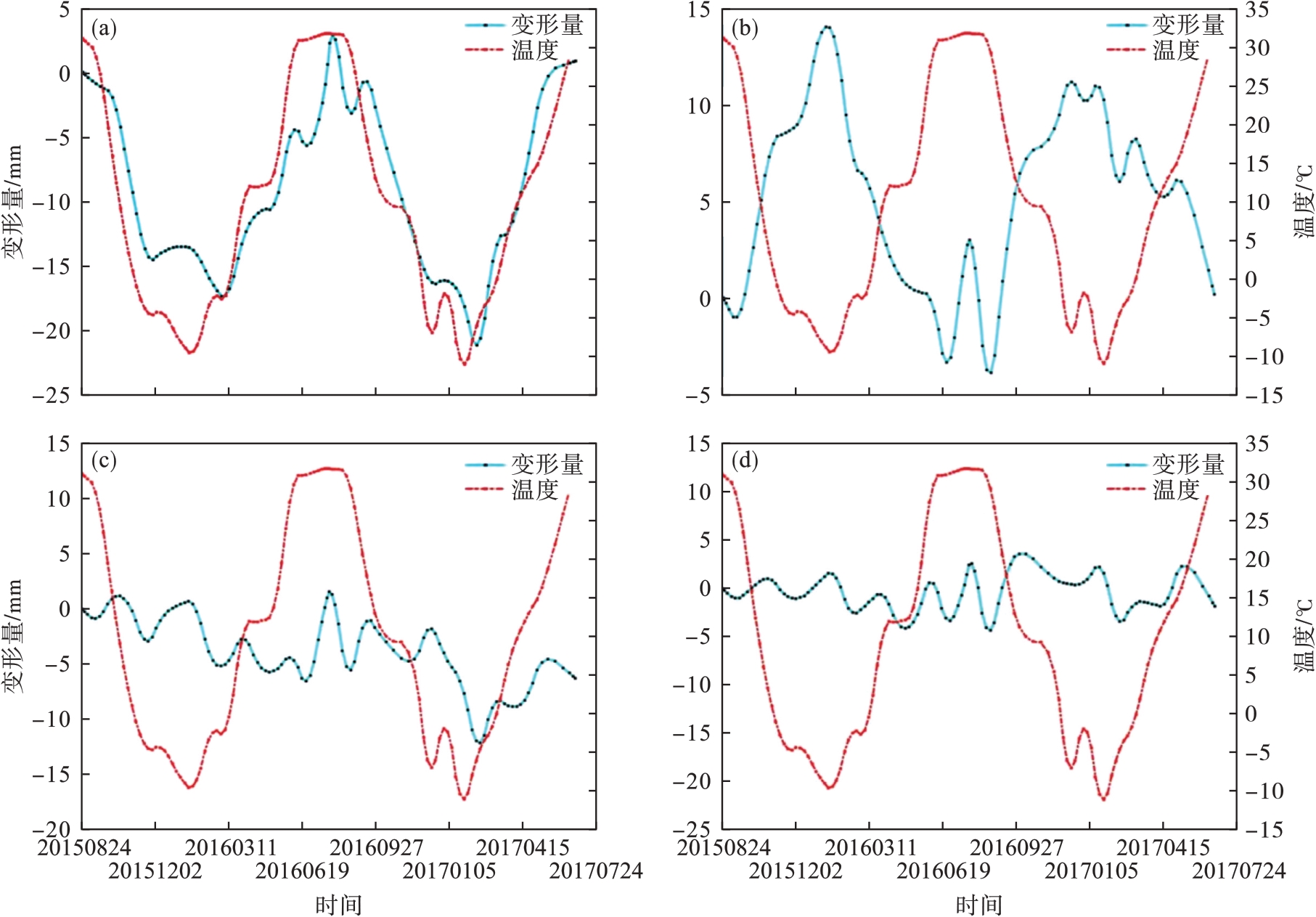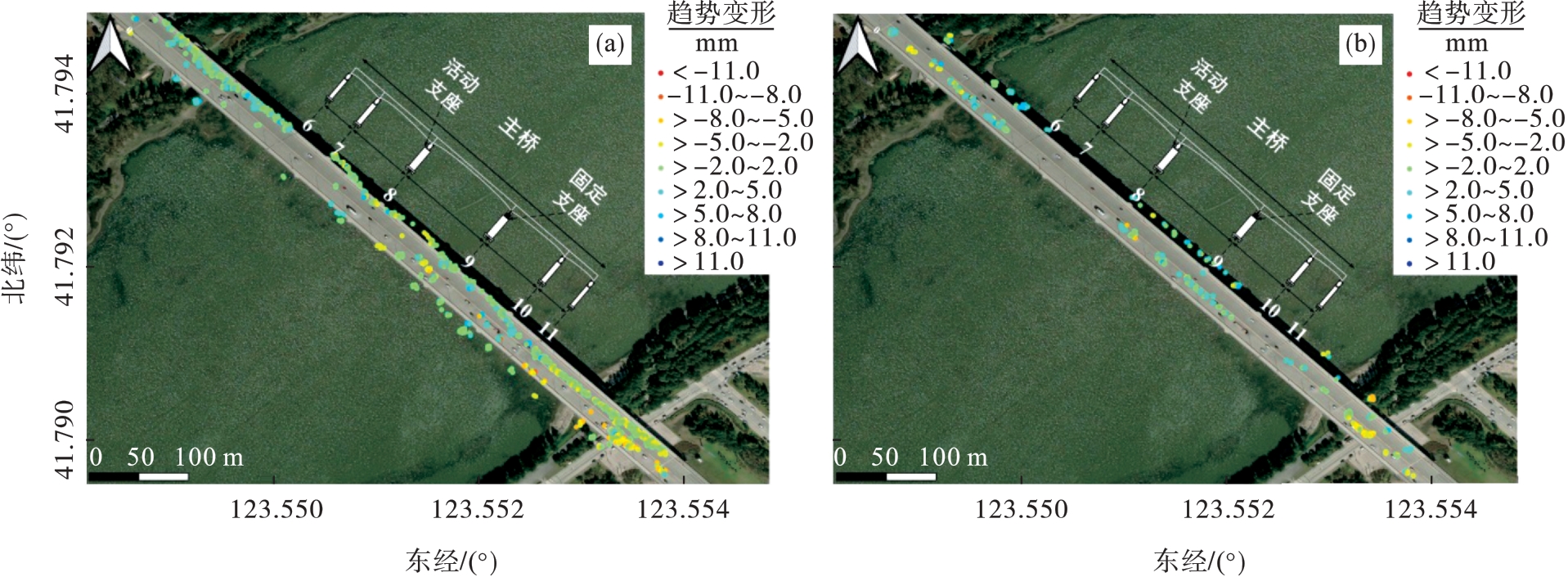
东北大学学报(自然科学版) ›› 2024, Vol. 45 ›› Issue (3): 391-400.DOI: 10.12068/j.issn.1005-3026.2024.03.011
收稿日期:2022-10-07
出版日期:2024-03-15
发布日期:2024-05-17
通讯作者:
敖萌
作者简介:魏恋欢(1986-),女,辽宁沈阳人,东北大学副教授,博士生导师.
基金资助:
Lian-huan WEI, Xiao-tian WANG, Meng AO( ), Xin LI
), Xin LI
Received:2022-10-07
Online:2024-03-15
Published:2024-05-17
Contact:
Meng AO
About author:AO Meng, E-mail: aomeng@mail.neu.edu.cn摘要:
针对桥梁精细变形监测问题,提出一种考虑由温度引起的桥梁变形(简称温度变形)的升降轨合成孔径雷达(synthetic aperture radar,SAR)数据融合方法.首先,以连续箱梁桥为研究对象,分别使用升降轨SAR数据集,基于小基线子集干涉测量法(small baseline subsets interferometric SAR,SBAS-InSAR)提取视线向(line‐of‐sight,LOS)变形;然后,利用最小二乘法构建温度变形模型,分离周期性温度变形与长期性趋势变形;最后,结合桥梁结构特征,基于时空插值和奇异值分解方法实现升降轨数据融合,提取温度变形、纵桥向(即桥梁延伸方向)及垂直向趋势变形,分析桥梁变形机制及变形成因.结果表明,该方法可提取精确的桥梁温度变形及三维变形,为桥梁健康监测提供可靠的方法支撑.
中图分类号:
魏恋欢, 王啸天, 敖萌, 李鑫. 基于升降轨SAR数据的连续箱梁桥精细变形[J]. 东北大学学报(自然科学版), 2024, 45(3): 391-400.
Lian-huan WEI, Xiao-tian WANG, Meng AO, Xin LI. Detailed Deformation of Continuous Box Girder Bridge Based on Ascending and Descending SAR Data[J]. Journal of Northeastern University(Natural Science), 2024, 45(3): 391-400.
| 传感器名称 | 轨道方向 | 航向角/(°) | 成像模式 | 分辨率/m | 入射角/(°) | 影像数量 | 覆盖时段 |
|---|---|---|---|---|---|---|---|
| TerraSAR-X | 升轨 | ~348.7 | 条带模式 | 3×3 | ~23.98 | 30 | 20150825—20170606 |
| COSMO-SkyMed | 降轨 | ~11.0 | 条带模式 | 3×3 | ~23.5 | 29 | 20150327—20170402 |
表1 SAR数据集详细参数
Table 1 Detailed parameters of the SAR datasets
| 传感器名称 | 轨道方向 | 航向角/(°) | 成像模式 | 分辨率/m | 入射角/(°) | 影像数量 | 覆盖时段 |
|---|---|---|---|---|---|---|---|
| TerraSAR-X | 升轨 | ~348.7 | 条带模式 | 3×3 | ~23.98 | 30 | 20150825—20170606 |
| COSMO-SkyMed | 降轨 | ~11.0 | 条带模式 | 3×3 | ~23.5 | 29 | 20150327—20170402 |

图6 新立堡桥关键点变形时间序列和温度变化曲线(a)—监测点1; (b)—监测点2; (c)—监测点3; (d)—监测点4.
Fig.6 Time‐series displacements and temperature change of several key points on the Xinlipu bridge

图8 去除温度变形后新立堡桥LOS向趋势变形(a)—TerraSAR-X LOS向趋势变形; (b)—COSMO-SkyMed LOS向趋势变形.
Fig.8 LOS trending deformation of the Xinlipu bridge after removal of thermal deformation
| 1 | 周婕,邱军,许辉,等.国内桥梁运营阶段坍塌事故案例分析[J].市政设施管理,2021(1):55-58. |
| Zhou Jie, Qiu Jun, Xu Hui,et al.Analysis of collapse accidents in domestic bridge operation stage[J].Management of Municipal Facilities,2021(1):55-58. | |
| 2 | 李文云,田龙飞.变形监测技术在桥梁监测中的应用[J].工程技术研究,2019,4(13):67-68. |
| Li Wen‐yun, Tian Long‐fei.Application of deformation monitoring technology in bridge monitoring[J].Engineering and Technology Research,2019,4(13):67-68. | |
| 3 | La H M, Lim R S, Basily B B,et al.Mechatronic systems design for an autonomous robotic system for high‐efficiency bridge deck inspection and evaluation[J].IEEE-ASME Transactions on Mechatronics,2013,18(6):1655-1664. |
| 4 | Pelagia G, Maria M.Application of classical land surveying measurement methods for determining the vertical displacement of railway bridges[J].Civil and Environmental Engineering Reports,2017,27(4):169-183. |
| 5 | 廖明生,王茹,杨梦诗,等.城市目标动态监测中的时序InSAR分析方法及应用[J].雷达学报,2020,9(3):409-424. |
| Liao Ming‐sheng, Wang Ru, Yang Meng‐shi,et al.Techniques and applications of spaceborne time‐series InSAR in urban dynamic monitoring[J].Journal of Radars,2020,9(3):409-424. | |
| 6 | Hanssen R F.Satellite radar interferometry for deformation monitoring:a priori assessment of feasibility and accuracy[J].International Journal of Applied Earth Observation and Geoinformation,2005,6:253-260. |
| 7 | Castellazzi P, Garfias J, Martel R,et al.InSAR to support sustainable urbanization over compacting aquifers:the case of Toluca Valley,Mexico[J].International Journal of Applied Earth Observation and Geoinformation,2017,63:33-44. |
| 8 | Chang L, Hanssen R F.Detection of cavity migration and sinkhole risk using radar interferometric time series[J].Remote Sensing of Environment,2014,147(5):56-64. |
| 9 | Berardino P, Fornaro G, Lanari R,et al.A new algorithm for surface deformation monitoring based on small baseline differential SAR interferograms[J].IEEE Transactions on Geoscience and Remote Sensing,2002,40(11):2375-2383. |
| 10 | Monserrat O, Crosetto M, Cuevas M,et al.The thermal expansion component of persistent scatterer interferometry observations[J].IEEE Geoscience and Remote Sensing Letters,2011,8(5):864-868. |
| 11 | Fornaro G, Reale D, Verde S.Bridge thermal dilation monitoring with millimeter sensitivity via multidimensional SAR imaging[J].IEEE Geoscience and Remote Sensing Letters,2013,10(4):677-681. |
| 12 | Qin X Q, Zhang L, Yang M S,et al.Mapping surface deformation and thermal dilation of arch bridges by structure‐driven multi‐temporal DInSAR analysis[J].Remote Sensing of Environment,2018,216(8):71-90. |
| 13 | Wang R J, Zhang J M, Liu X L.A most‐unfavorable‐condition method for bridge‐damage detection and analysis using PSP‐InSAR[J].Remote Sensing,2022,14(1):1-19. |
| 14 | Lanari R, Reale D, Bonano M,et al.Comment on “pre‐collapse space geodetic observations of critical infrastructure:the Morandi bridge,Genoa,Italy”[J].Remote Sensing,2020,12(24):1-16. |
| 15 | 朱茂,沈体雁,吕凤华,等.青岛胶州湾跨海大桥InSAR形变数据分解和信息提取[J].遥感学报,2020,24(7):883-893. |
| Zhu Mao, Shen Ti‑yan, Feng‑hua Lyu,et al.InSAR deformation data decomposition and information analysis of Jiaozhou bay bridge,Qingdao[J].Journal of Remote Sensing(Chinese),2020,24(7):883-893. | |
| 16 | Cusson D, Rossi C, Ozkan I F.Early warning system for the detection of unexpected bridge displacements from radar satellite data[J].Journal of Civil Structual Health Monitoring,2021,11(1):189-204. |
| 17 | Xiong S T, Wang C S, Qin X Q,et al.Time‐series analysis on persistent scatter‐interferometric synthetic aperture radar(PS-InSAR) derived displacements of the Hong Kong‐Zhuhai‐Macao bridge(HZMB) from Sentinel-1A observations[J].Remote Sensing,2021,13(4):1-18. |
| 18 | Markogiannaki O, Chen F, Parcharidis I,et al.Monitoring of a landmark bridge using SAR interferometry coupled with engineering data and forensics[J].International Journal of Remote Sensing,2022,43(1):95-119. |
| 19 | Crosetto M, Monserrat O, Iglesias R,et al.Persistent scatterer interferometry:potential,limits and initial C‑and X‑band comparison[J].Photogrammetric Engineering and Remote Sensing,2010,76(9):1061-1069. |
| 20 | Huang Q H, Monserrat O, Crosetto M,et al.Displacement monitoring and health evaluation of two bridges using Sentinel-1 SAR images[J].Remote Sensing,2018,10(11):1-18. |
| 21 | Lazecky M, Hlavacova I, Bakon M,et al.Bridge displacement monitoring using space‐borne X‑band SAR interferometry[J].IEEE Journal of Selected Topics in Applied Earth Observations and Remote Sensing,2017,10(1):205-210. |
| 22 | Selvakumaran S, Rossi C, Marinoni A,et al.Combined InSAR and terrestrial structural monitoring of bridges[J].IEEE Transactions on Geoscience and Remote Sensing,2020,58(10):7141-7153. |
| 23 | 魏恋欢,封秋月,毛亚纯,等.基于多轨道SBAS方法的露天矿高陡边坡形变监测[J].东北大学学报(自然科学版),2020,41(10):1445-1451. |
| Wei Lian‐huan, Feng Qiu‐yue, Mao Ya‐chun,et al.Deformation monitoring of high steep slope in open‐pit mine with multi‐orbit SBAS[J].Journal of Northeastern University(Natural Science),2020,41(10):1445-1451. | |
| 24 | 中交公路规划设计院. 公路桥涵设计通用规范: [S].北京:人民交通出版社,2015:63-65. |
| Ministry of Transport of China‐Highway Planning and Design Institute. General specifications for design of highway bridges and culverts: [S].Beijing:China Communications Press,2015:63-65. | |
| 25 | 敖萌,张路,廖明生,等.基于方差分量估计的多源InSAR数据自适应融合形变测量[J].地球物理学报,2020,63(8):2901-2911. |
| Ao Meng, Zhang Lu, Liao Ming‐sheng,et al.Deformation monitoring with adaptive integration of multi‐source InSAR data based on variance component estimation[J].Chinese Journal of Geophysics(in Chinese),2020,63(8):2901-2911. | |
| 26 | 中华人民共和国住房和城乡建设部. 城市桥梁检测与评定技术规范: [S].北京:中国建筑工业出版社,2016. |
| Ministry of Housing and Urban‑Rural Development of the People’s Republic of China. Technical code for test and evaluation of city bridges: [S].Beijing:China Architecture & Building Press,2016. |
| [1] | 魏恋欢, 封秋月, 毛亚纯, 刘善军. 基于多轨道SBAS方法的露天矿高陡边坡形变监测[J]. 东北大学学报:自然科学版, 2020, 41(10): 1445-1451. |
| [2] | 叶正旺, 温涛, 刘振宇, 付崇国. 基于信任模型的WSNs安全数据融合算法[J]. 东北大学学报:自然科学版, 2019, 40(6): 789-794. |
| [3] | 孙爽, 梁力, 李明, 李鑫. 基于动力指纹和Bayes数据融合的桥梁损伤识别[J]. 东北大学学报:自然科学版, 2017, 38(2): 290-294. |
| [4] | 吴伟;刘兴刚;王忠实;徐心和;. 多传感器融合实现机器人精确定位[J]. 东北大学学报(自然科学版), 2007, 28(2): 161-164. |
| [5] | 杜庆东;徐凌宇;赵海. 基于分布式结构的判决反馈数据融合算法[J]. 东北大学学报(自然科学版), 2001, 22(4): 385-388. |
| [6] | 张德干;郝先臣;尹国成;赵海. 基于神经元网络的发电机融合控制方法[J]. 东北大学学报(自然科学版), 2001, 22(3): 249-252. |
| [7] | 杜庆东;徐凌宇;赵海. 基于D-S证据理论与嵌入式传感器的监控与故障诊断[J]. 东北大学学报(自然科学版), 2000, 21(6): 594-597. |
| [8] | 张德干;郝先臣;高光来;赵海. 一种基于快速傅立叶变换的小波变换方法[J]. 东北大学学报(自然科学版), 2000, 21(6): 598-601. |
| [9] | 赵海;王光兴. 数据融合论在机器人系统设计中的应用[J]. 东北大学学报:自然科学版, 1995, 16(3): 5--. |
| 阅读次数 | ||||||
|
全文 |
|
|||||
|
摘要 |
|
|||||